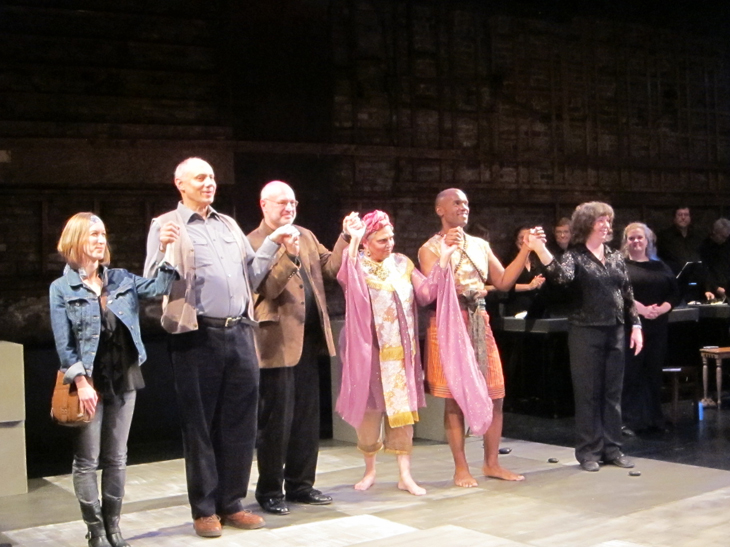“Dance of the Stones” in Review
“Dance of the Stones” in Review A Chamber Opera by Brian Schober Libretto by Richard Olson Theatre80, New York, NY November 6, 2010
A large audience was in attendance for the premiere weekend of Brian Schober’s new chamber opera “Dance of the Stones,” a work inspired by Japanese Noh drama, but involving modern, everyday characters searching for meaning in life. Delving into universal themes of mind and body, teacher and student, the limitations of words, love, and aging, the opera’s scope seems to reach in inverse proportion to the size of the cast (four characters and a small chorus). The uncluttered quality of cast and staging combined with an evocative musical score to create illusions of space and time that far exceeded the intimate venue.
Central to the story, in a libretto by Richard Olson, is the relationship between a frustrated philosophy professor, Thom (sung by bass-baritone Peter Ludwig), and a young infatuated student Abby (sung by soprano Sara Paar). They travel towards enlightenment and towards Thom’s own revered teacher Tara (sung by contralto Christina Ascher), aided by a guide named Go (tenor Kenneth Harmon). Appropriately subtitled “A Journey beyond Words,” much of the opera’s emotional story is conveyed through dance, pantomime, and choral interludes that draw upon a rich range of what is described as “multi-textured music of shifting modalities.” There are indeed words as well, sung very conversationally by the four main characters (and peppered humorously with some slang), but the instrumental and choral music, lighting, and staging seem best to express the heart of the characters, the subtext of their lines, and their journeys toward truth. A chorus with handbells plus an ensemble of violin, cello, flutes, piccolo, clarinet, piano, synthesizer, harp and percussion convey alternately a sense of frustration, wonder, anxiety, love, calm, and sleep.
Mr. Schober, an American composer and organist who studied in France with Olivier Messiaen (as well as in the US), seems to have some of Messiaen’s mark on his musical style, although his wide-ranging textures and timbres are so sensitively connected to his opera’s drama and libretto that what emerges is something altogether unique.
The composition is fascinating all by itself, though non-musicians would enjoy the production for its theatrical values alone, including skillful choreography (Lynn Neumann) and lighting (Stephen Petrilli). All was held together seamlessly by the skillful conducting of Claudia Dumschat. In the performance I heard, the singing and acting were commendable, although occasionally some recitative parts were a tad stilted. The initially fusty Thom metamorphosed wonderfully as the role progressed, and some humorous moments stole the show for the spunky Abby, also offering much-needed comic relief from the rather ambitious subject matter. I never thought I would hear the word “dude” sung in a classical opera setting, but there is a first for everything!
Special mention should be made also of the chorus’s soprano soloist, Lesley Zlabinger, who had some of the most beautifully lyrical parts, and of considerable difficulty. Considering the obvious difficulty in all of the vocal parts (and in coordination with the ensemble parts), it was a remarkable and impressive premiere. All involved are to be congratulated.
One can easily imagine this chamber opera receiving repeat performances or touring the university circuit (despite some derogatory references in the text to “ivory towers”). Its small cast and simple staging should make it quite mobile, and college audiences should find it provocative. There may also be something of a renewed interest in Noh-inspired opera, as a new production of one by Alexander Goehr was just presented in London. There are also notable early examples by Benjamin Britten, in his “Curlew River,” “The Fiery Burning Furnace,” and “The Prodigal Son,” but there is certainly room for more.

